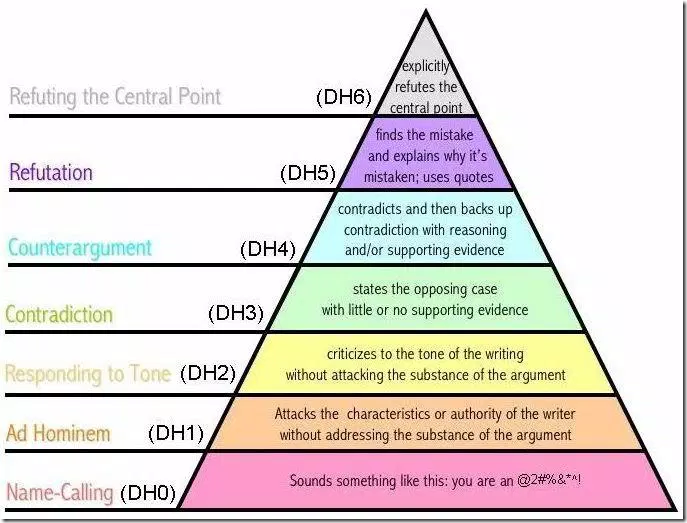The Pyramid of Disagreement: A Critical Tool for Analyzing Arguments
An essential skill in evaluating and discussing, mastering the ability to recognize the level of disagreement to which you and/or your opponents are appealing will help discernment to be achieved in almost any debate. Originally posted in April, 2008.
~~~~~~~
Man, once surrendering his reason, has no remaining guard against absurdities… With such persons, gullibility, which they call faith, takes the helm from the hand of reason and the mind becomes a wreck.
Thomas Jefferson
When confronted with an idea, proposition, or any content with which one disagrees, several responses are possible. One can ignore it, consider the points of disagreement and become convinced that they are correct and you have been mistaken, or one can continue to disagree and make an attempt at explaining why. Here in the blogosphere, this frequently occurs in the comments section, although the size limitation makes extended and detailed discussions difficult at times.
Nonetheless, to be effective, an effort should be made in determining how to do so. To that end, the preeminent anti-Idiotarian, Dr. Sanity, has brought to light this essay by Paul Graham entitled How to Disagree, which has been supplemented here with this tremendously valuable graphic depicting the Pyramid of Disagreement in which the various possible methods of disagreement are ranked in order of prevalence and effectiveness.
As you move up the pyramid, the effectiveness increases. Mr. Graham labels the bottom method DH0 (Disagreement Hierarchy) on up to DH6. It is important to note that anything below DH4 (counterargument) he labels as “unconvincing,” but could also be labeled “invalid,” or “ineffective.” Thus, if one truly wants to convincingly deal with a topic, one should engage in counterargument (DH4), refutation (DH5), and/or refuting the central point (DH6).
An additional benefit of this pyramid is the ability to recognize what kind of presentation one is reviewing or formulating, i.e., it serves as a tool for analysis of argumentation by providing a framework to judge the level of effectiveness of an argument, another’s or your own.
In general, if the point is to convince and persuade, you want to stick to the upper levels of argumentation. Unfortunately, these usually take more effort and are longer to prepare that the vastly easier lower levels. The progression up and down this pyramid can be correlated with at least two other characteristics: level of rationality and its converse, the level of emotionalism. The higher up the pyramid, the more you have to think and use rational argumentation. The more you sink to the lower levels, the more likely it is you will sink into emoting and reacting without thinking, and thus end up with drivel. The most petulant and peevish exchanges occur at these lower levels, especially at DH0. In addition, this pyramid helps to explain at least one potentially confusing couplet in Proverbs that some take as a contradiction:
Answer not a fool according to his folly, lest thou also be like unto him. Answer a fool according to his folly, lest he be wise in his own conceit. (Proverbs 26:4-5)
Let’s first note that a fool will most likely answer with the folly of a DH0 or DH1 level response. The more intellectual ones might make it to DH2. So, don’t respond in kind, at the same level, because then you’ll be just like him, and you’ll be operating in the realm of the unconvincing. Yet there are times when it is necessary to formulate some response so that he doesn’t think he’s won (becoming "wise in his own conceit") and so that he doesn’t distort and corrupt someone else’s thinking with his poisonous pabulum. In those cases, you respond at DH4-DH6. With this framework, we see the statements are complementary and not contradictory.
As conservatives, let’s commit ourselves to operating at the DH4 and higher levels in our intercourse here in the blogosphere. If nothing else, it will drive liberals crazy!
ADDENDUM: Two further thoughts on DH0 level discussion, i.e., name-calling responses. First is one that Mr. Graham makes in the essay linked above: it doesn’t matter if one sinks into the gutter of vulgarity to call someone a [explicative deleted] or if one rises to the lexicon of loquacity to label someone a “poltroon of plenitudinous proportions,” it is still name-calling and does not address the issue under discussion and thus is only effective to the author in an emotive, cathartic way (which still may have some value for said author of such a comment, but does nothing to prove any point, or even that the name is an accurate assessment of the one to whom it is ascribed).
The second point is to answer the question, is it ever right to assign a derogatory label to someone, i.e., is name-calling a valid response in some situations? Here, I think there is a fine but finite distinction to be made between a.) responding to an argument and b.) attempting to describe someone or something based on the evidence at hand. Name-calling never answers an argument, period. Thus, it is never a valid response as a counterargument. However, some labels are accurate descriptors if sufficient data has been presented to make the case to use such a label. For example, it is not too difficult to label many liberals today as socialists because one can take their own statements and compare them to the statements found in socialist documents and find identity clearly manifested. Thus, based on the data, labeling someone with a name based on evidence is a valid exercise. It still is not an argument, but it consolidates data, is subject to verification and falsification, and can serve as a basis for argumentation.
Any additional thoughts on this or any other aspect of the pyramid are welcome.
ADDENDUM #2: For an interesting example of God Himself engaged in what I’m talking about in the Addendum above, check out Matthew 23, where Jesus takes on the religious leaders of the day with less than P.C. bluntness. It is critical to note that He supplies multiple examples of their behavior as evidence to justify the names He uses to accurately characterize the fruit of their lives. The grand finale of His indictment is in verse 33:
Ye serpents, ye generation of vipers, how can ye escape the damnation of hell?
While this appears to be DH0 level “disagreement,” the juxtaposition to the evidence indicates otherwise: it is a descriptor and not an argument. His argument consists of the multiple examples where the religious leaders have consistently shown their contempt for God’s law by their meticulous search for all the loopholes they can find in their hypocritical pursuit of their own righteousness.
As a sidebar, let me also note that despite its vehemence, Jesus is not engaged in irrational emoting or an angry diatribe, although it is probably fair to say that a modicum of righteous anger/indignation was present. Jesus had and displayed emotion, but always under control. As one clear example of this, check out His cleansing of the Temple (e.g., John 2:13-17). Large cattle are not particularly easy to move, and turning over tables constructed to hold the necessary items of trade (scales, weights, coins) was not a job for a limp wimp (carpentry in this day and age would have provided any carpenter of the day with a good physical fitness program). We appear to see Jesus having a temper tantrum, but verse 16 we see the evidence that gives the lie to that conclusion:
And said unto them that sold doves, Take these things hence; make not my Father’s house an house of merchandise.
In contrast to the larger cattle for sacrifices, doves are fragile birds that were in cages. Rather than throwing these to the ground and hurting the birds, He calmly commands their owners to pick them up and get them out…NOW! In so doing, He demonstrates His self-control even in the midst of an apparent storm. Of course, being the sinless Son of God also makes these kinds of activities substantially “safer” for Jesus than for us (James 1:20).




Recent Comments